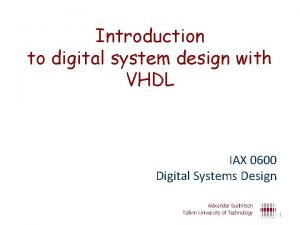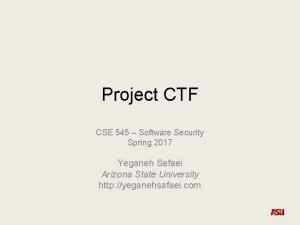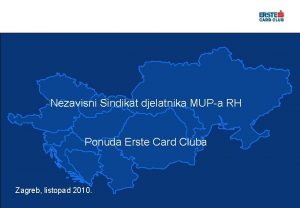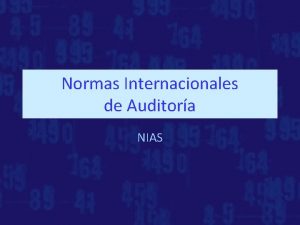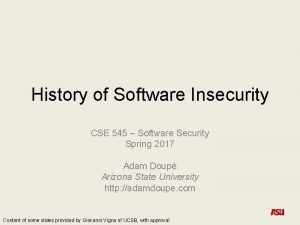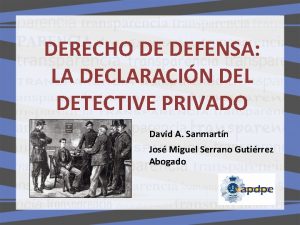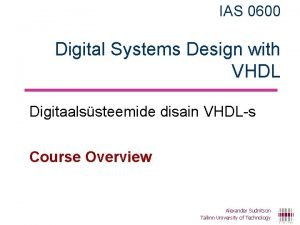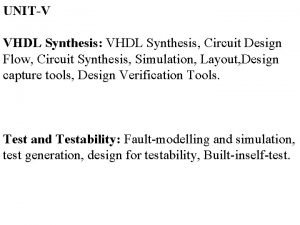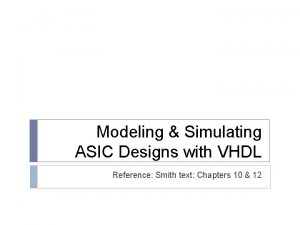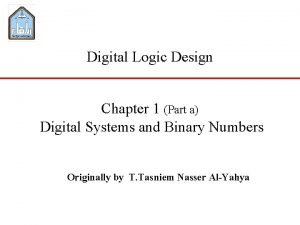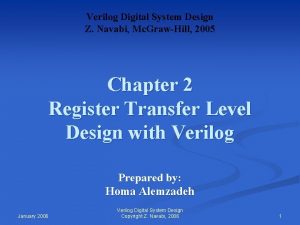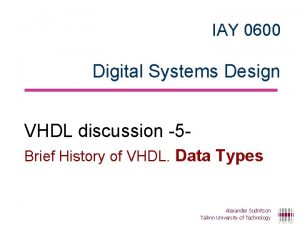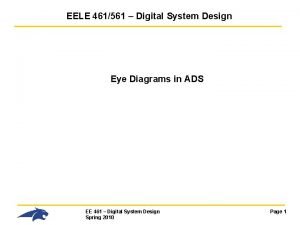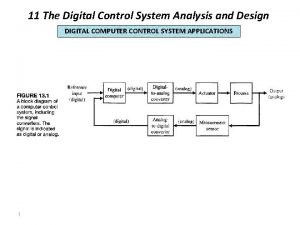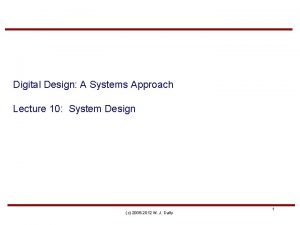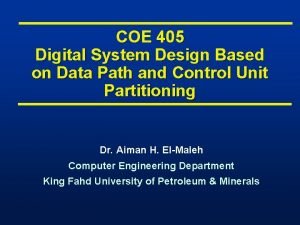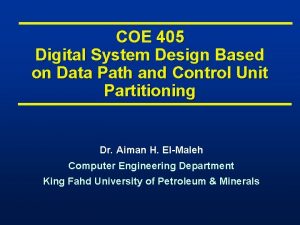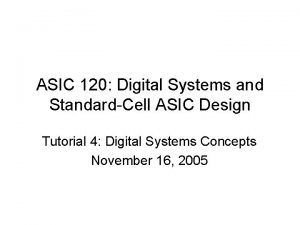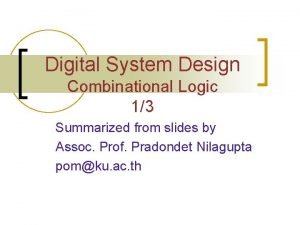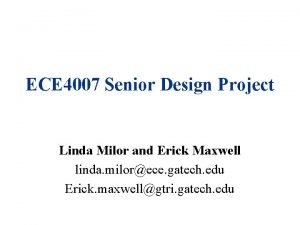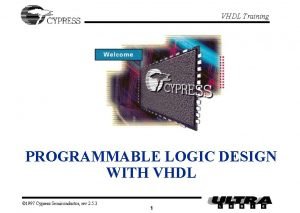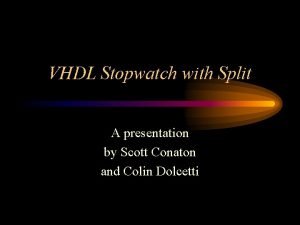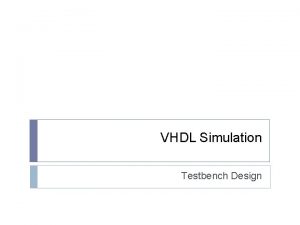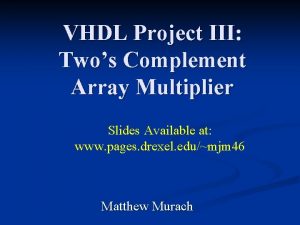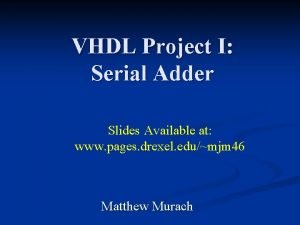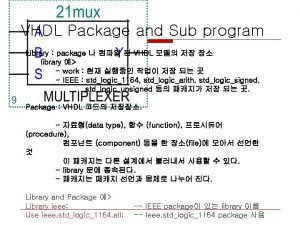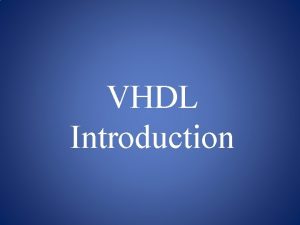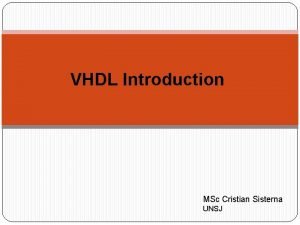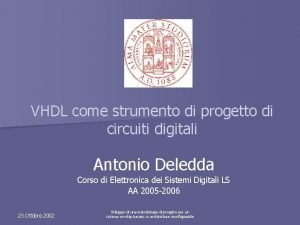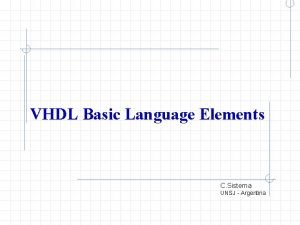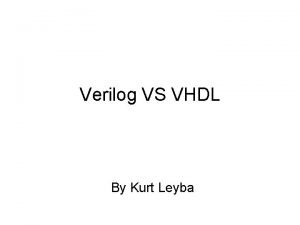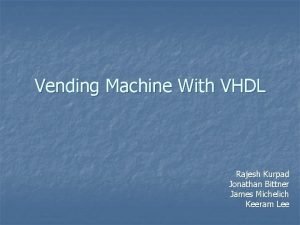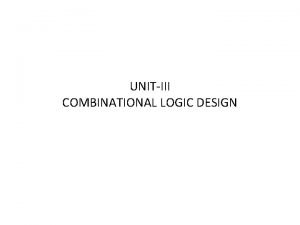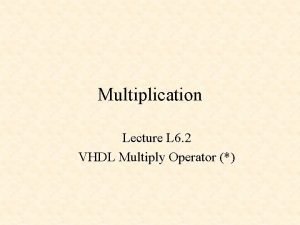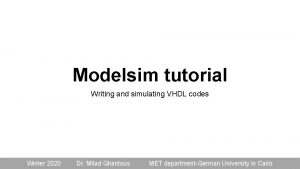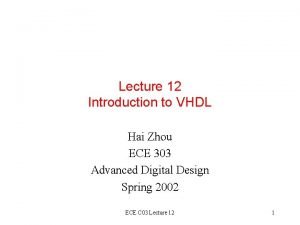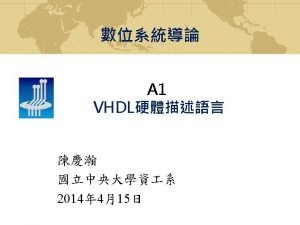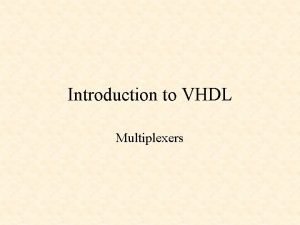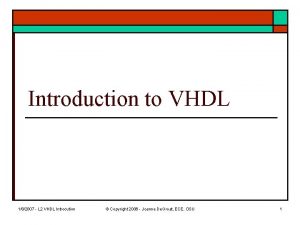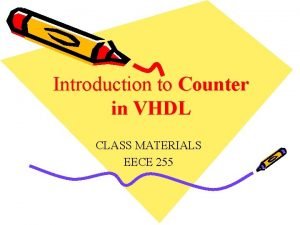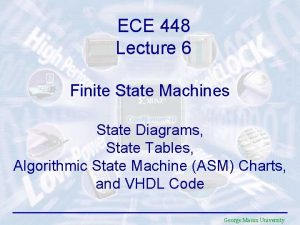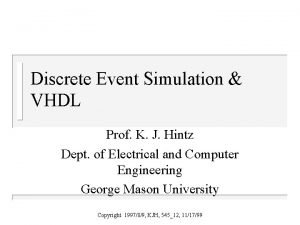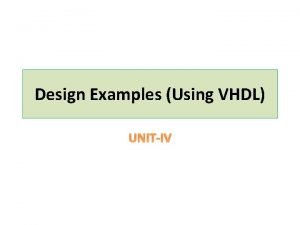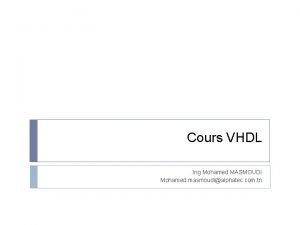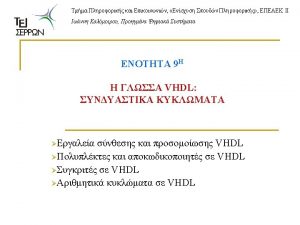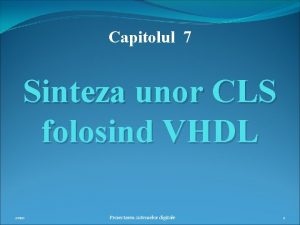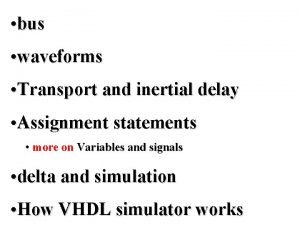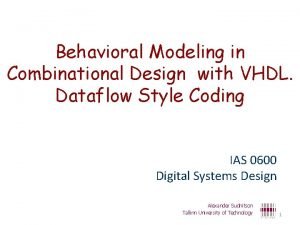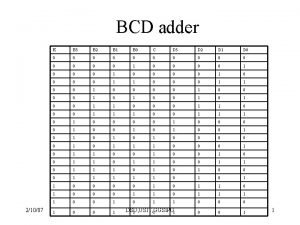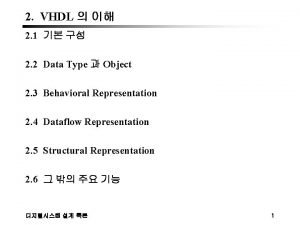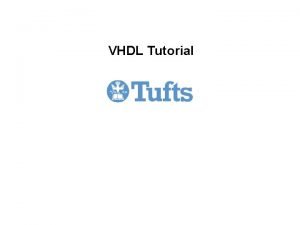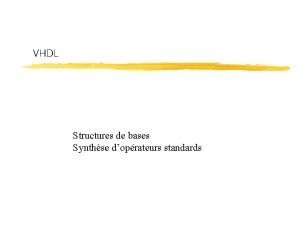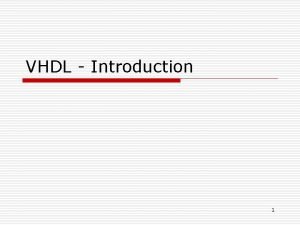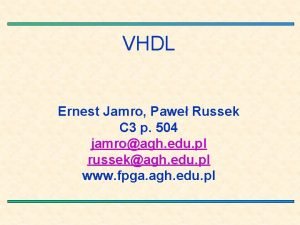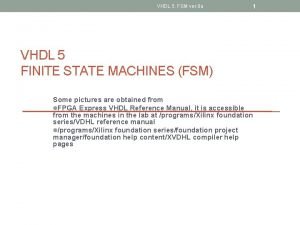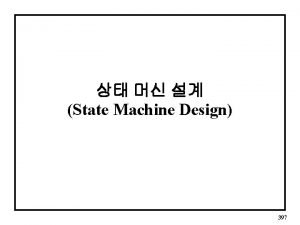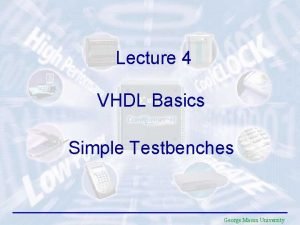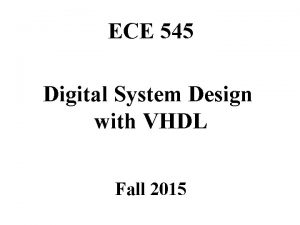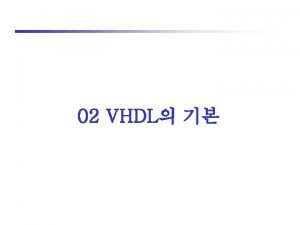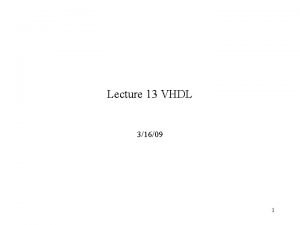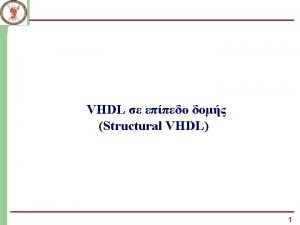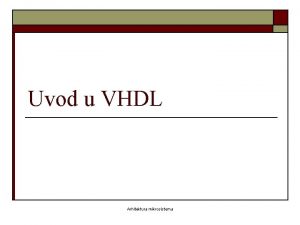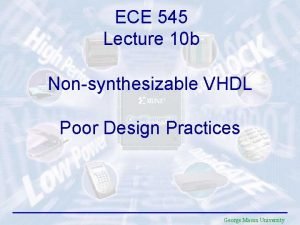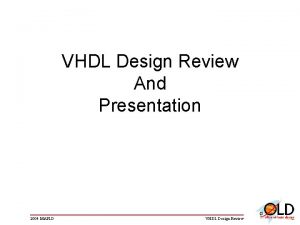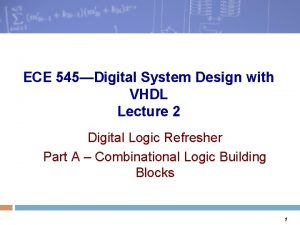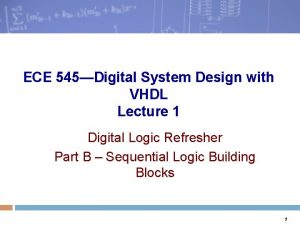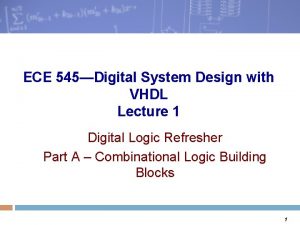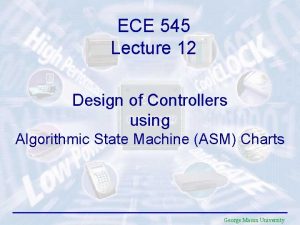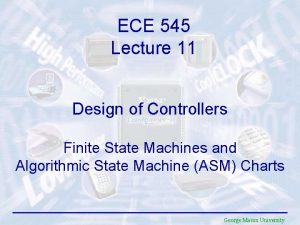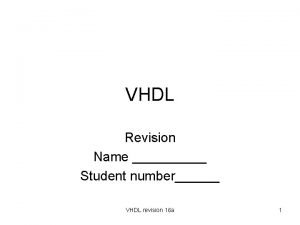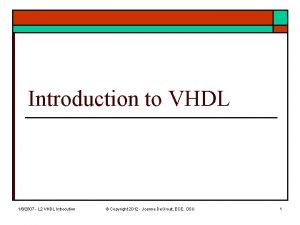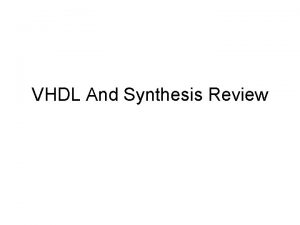ECE 545 Digital System Design with VHDL Course



















































![Efficiency in software: NIST-specified platform 200 MHz Pentium Pro, Borland C++ Throughput [Mbits/s] 128 Efficiency in software: NIST-specified platform 200 MHz Pentium Pro, Borland C++ Throughput [Mbits/s] 128](https://slidetodoc.com/presentation_image_h2/5711a50d59ddaeea27d3817354695156/image-52.jpg)

![Efficiency in FPGAs: Speed Xilinx Virtex XCV-1000 Throughput [Mbit/s] 500 450 400 350 300 Efficiency in FPGAs: Speed Xilinx Virtex XCV-1000 Throughput [Mbit/s] 500 450 400 350 300](https://slidetodoc.com/presentation_image_h2/5711a50d59ddaeea27d3817354695156/image-54.jpg)
![Efficiency in ASICs: Speed Throughput [Mbit/s] 700 MOSIS 0. 5μm, NSA Group 606 128 Efficiency in ASICs: Speed Throughput [Mbit/s] 700 MOSIS 0. 5μm, NSA Group 606 128](https://slidetodoc.com/presentation_image_h2/5711a50d59ddaeea27d3817354695156/image-55.jpg)




























- Slides: 83

ECE 545 Digital System Design with VHDL Course web page: ECE web page Courses ECE 545

Kris Gaj Research and teaching interests: • reconfigurable computing • computer arithmetic • cryptography • network security Contact: The Engineering Building, room 3225 kgaj@gmu. edu Office hours: Thursday, 7: 30 -8: 30 PM, Tuesday, 6: 00 -7: 00 PM, and by appointment

ECE 545 Part of: MS in Computer Engineering One of five core courses (must be passed with B or better) Fundamental course for the specialization areas: Digital Systems Design Digital Signal Processing Elective course in the remaining specialization areas MS in Electrical Engineering Elective

ECE 545 Part of: Ph. D in Electrical and Computer Engineering Knowledge tested at the Technical Qualifying Exam (TQE) Topic 2: Digital Design and Computer Organization

I am interested in… I want to specialize primarily in… CAD tools & Design Automation VLSI Hardware Description Languages Recommended program & specialization MS Cp. E Digital Systems Design FPGAs & Reconfigurable computing ASICs & FPGAs Computer Arithmetic VHDL/Verilog Front-end ASIC Design (algorithmic downto gate level) CAD Tools Reconfigurable Computing Back-end ASIC Design (circuit and mask layout levels) Analog & Digital Circuit Design Microelectronics VLSI Fabrication Microelectronics Nanoelectronics Semiconductor Devices MS EE Microelectronics/ Nanoelectronics

Courses Design level Digital System Computer Design with VHDL Arithmetic VLSI Design VLSI Test for ASICs Concepts algorithmic register-transfer ECE 545 gate transistor layout devices ECE 645 ECE 586 ECE 680 ECE 681 ECE 682 Digital Integrated Circuits Physical VLSI Design Semiconductor ECE 584 ECE 684 Device Fundamentals MOS Device Electronics

Cp. E Digital Systems Design Pre. Approved Electives ECE 545 Digital System Design with VHDL ECE 586 Digital Integrated Circuits ECE 645 Computer Arithmetic ECE 681 VLSI Design for ASICs ECE 682 VLSI Test Concepts ECE 699 DSP HW Architectures Cp. E Microprocessors and Embedded Systems ECE 510 Real-Time Concepts ECE 511 Microprocessors ECE 611 Advanced Microprocessors ECE 612 Real-Time Embedded Systems ECE 641 Computer System Architecture Suggested Electives CS 540, 583 (languages, algorithms) CS 635 (parallel machines) ECE 584, 684, … (technology) ECE 511, 611, … (microprocessors) ECE 542, 642, 742 (networks) ECE 537, 646, 746, …(applications) ECE 645, 681 (digital design) ECE 548 (sequential mach. theory) Professors K. Gaj, K. Hintz, H. Homayoun, T. Storey, A. Cohen H. Homayoun, J. Kaps, P. Pachowicz, C. Sabzevari

DIGITAL SYSTEMS DESIGN Concentration advisors: Kris Gaj, Ken Hintz, Houman Homayoun 1. ECE 545 Digital System Design with VHDL – K. Gaj, project, FPGA design with VHDL, 2. ECE 645 Computer Arithmetic – K. Gaj, project, FPGA design with VHDL 3. ECE 681 VLSI Design for ASICs – H. Homayoun, project/lab, front-end and back-end ASIC design with Synopsys tools 4. ECE 586 Digital Integrated Circuits – D. Ioannou, R. Mulpuri, 5 a. ECE 682 VLSI Test Concepts – T. Storey 5 b. ECE 699 Digital Signals Processing Hardware Architectures – A. Cohen, project, FPGA design with VHDL and Matlab/Simulink

DIGITAL SIGNAL PROCESSING Concentration advisors: Aaron Cohen, Kris Gaj, Ken Hintz, Jill Nelson, Kathleen Wage 1. ECE 535 Digital Signal Processing – L. Griffiths, J. Nelson, Matlab 2. ECE 545 Digital System Design with VHDL – K. Gaj, project, FPGA design with VHDL 3. ECE 645 Computer Arithmetic – K. Gaj, project, FPGA design with VHDL 4. ECE 699 Digital Signals Processing Hardware Architectures – A. Cohen, project, FPGA design with VHDL and Matlab/Simulink 5 a. ECE 537 Introduction to Digital Image Processing – K. Hintz 5 b. ECE 738 Advanced Digital Signal Processing – K. Wage

Grading Scheme • Homework - 15% • Project - 35% • Midterm Exam - 20% • Final Exam - 30%

Midterm exam 1 ü 2 hours 40 minutes ü in class ü design-oriented ü open-books, open-notes ü practice exams available on the web Tentative date: Last week of October

Final exam ü 2 hours 45 minutes ü in class ü design-oriented ü open-books, open-notes ü practice exams available on the web Date: Thursday, December 12, 4: 30 -7: 15 pm

Textbooks 13

Required Textbook Pong P. Chu, RTL Hardware Design Using VHDL, Wiley-Interscience, 2006.

Supplementary Textbook – Basics Refresher Stephen Brown and Zvonko Vranesic, Fundamentals of Digital Logic with VHDL Design, Mc. Graw-Hill, 3 rd or 2 nd Edition

Supplementary Textbook – Advanced Hubert Kaeslin, Digital Integrated Circuit Design: From VLSI Architectures to CMOS Fabrication, Cambridge University Press; 1 st Edition, 2008. Used in ECE 681 “VLSI Design for ASICs”

Technology & Tools 17

What is an FPGA? Configurable Logic Blocks Block RAMs I/O Blocks Block RAMs

FPGA Design process (1) Design and implement a simple unit permitting to speed up encryption with RC 5 -similar cipher with fixed key set on 8031 microcontroller. Unlike in the experiment 5, this time your unit has to be able to perform an encryption algorithm by itself, executing 32 rounds…. . Specification / Pseudocode On-paper hardware design (Block diagram & ASM chart) VHDL description (Your Source Files) Library IEEE; use ieee. std_logic_1164. all; use ieee. std_logic_unsigned. all; Functional simulation entity RC 5_core is port( clock, reset, encr_decr: in std_logic; data_input: in std_logic_vector(31 downto 0); data_output: out std_logic_vector(31 downto 0); out_full: in std_logic; key_input: in std_logic_vector(31 downto 0); key_read: out std_logic; ); end AES_core; Synthesis Post-synthesis simulation

FPGA Design process (2) Implementation Timing simulation Configuration On chip testing

Simulation Tools



FPGA Synthesis Tools

Logic Synthesis VHDL description architecture MLU_DATAFLOW of MLU is signal A 1: STD_LOGIC; signal B 1: STD_LOGIC; signal Y 1: STD_LOGIC; signal MUX_0, MUX_1, MUX_2, MUX_3: STD_LOGIC; begin A 1<=A when (NEG_A='0') else not A; B 1<=B when (NEG_B='0') else not B; Y<=Y 1 when (NEG_Y='0') else not Y 1; MUX_0<=A 1 and B 1; MUX_1<=A 1 or B 1; MUX_2<=A 1 xor B 1; MUX_3<=A 1 xnor B 1; with (L 1 & L 0) select Y 1<=MUX_0 when "00", MUX_1 when "01", MUX_2 when "10", MUX_3 when others; end MLU_DATAFLOW; Circuit netlist

FPGA Implementation • After synthesis the entire implementation process is performed by FPGA vendor tools


Design Process control from Active-HDL

Xilinx FPGA Tools ECE Labs Aldec Active-HDL Design Flow Xilinx ISE Design Flow Aldec Active-HDL (IDE) Model. Sim or ISim Xilinx XST or Synopsys Synplify Premier Xilinx ISE Design Suite (IDE) simulation synthesis implementation

Xilinx FPGA Tools Home Xilinx ISE Design Flow Aldec Active-HDL Student Edition (IDE) ISim Xilinx XST (restricted) Xilinx ISE Web. PACK (IDE) (restricted) simulation synthesis implementation

Altera FPGA Tools ECE Labs Altera Design Flow Mentor Graphics Model. Sim-Altera Quartus II Subscription Edition simulation synthesis & implementation

Altera FPGA Tools Home Altera Design Flow Mentor Graphics Model. Sim-Altera Starter (restricted) Altera Quartus II Web Edition (restricted) simulation synthesis & implementation

Project 33

Two Major Areas to Choose From ü Cryptography ü Digital Signal Processing

Cryptography Project ü requires knowledge of C or Java ürelated to the research project conducted by Cryptographic Engineering Research Group (CERG) at GMU ü supporting NIST (National Institute of Standards and Technology) in the evaluation of candidates for a new cryptographic standard

DSP Project (1) ü requires knowledge of Matlab and basics of digital signal processing ü processing of waveform audio files (. wav, . wave) and images ü co-advised by Dr. Aaron Cohen ü recommended (but not required) for students who would like to specialize in digital signal processing üsoft introduction to ECE 699 Digital Signals Processing Hardware Architectures

DSP Project (2) Examples of Topics: ü Signal Spectrum Analyzer (FFT) ü Vo. IP Conference Call voice mixing ü Background adaptive noise canceling ü Video/Audio codecs ü Classifiers (Speech Recognition) ü Adaptive Filtering with Quantization ü Compressed Sensing Solver for Piano Notes

Background for Cryptography Projects 38

Crypto 101

Cryptography is Everywhere Buying a book on-line Teleconferencing over Intranets Withdrawing cash from ATM Backing up files on remote server

Cryptographic Standards Before 1997 Secret-Key Block Ciphers IBM & NSA DES – Data Encryption Standard Triple DES 1993 1995 Hash Functions 2003 SHA-1–Secure Hash Algorithm NSA SHA-2 SHA 1970 2005 1999 1977 1980 1990 2000 2010 time

Why a Contest for a Cryptographic Standard? • Avoid back-door theories • Speed-up the acceptance of the standard • Stimulate non-classified research on methods of designing a specific cryptographic transformation • Focus the effort of a relatively small cryptographic community

Cryptographic Standard Contests IX. 1997 X. 2000 AES 15 block ciphers 1 winner NESSIE I. 2000 XII. 2002 CRYPTREC V. 2008 XI. 2004 34 stream ciphers 4 HW winners + 4 SW winners e. STREAM XII. 2012 X. 2007 51 hash functions 1 winner SHA-3 96 97 98 99 00 01 02 03 04 05 06 07 08 09 10 11 12 13 time

Cryptographic Contests - Evaluation Criteria Security Software Efficiency μProcessors Hardware Efficiency μControllers Flexibility Simplicity FPGAs ASICs Licensing 44

Specific Challenges of Evaluations in Cryptographic Contests • Very wide range of possible applications, and as a result performance and cost targets throughput: single Mbits/s to hundreds Gbits/s cost: single cents to thousands of dollars • Winner in use for the next 20 -30 years, implemented using technologies not in existence today • Large number of candidates • Limited time for evaluation • Only one winner and the results are final

Mitigating Circumstances • Security is a primary criterion • Performance of competing algorithms tend to very significantly (sometimes as much as 500 times) • Only relatively large differences in performance matter (typically at least 20%) • Multiple groups independently implement the same algorithms (catching mistakes, comparing best results, etc. ) • Second best may be good enough

AES Contest 1997 -2000

Rules of the Contest Each team submits Detailed cipher specification Justification of design decisions Source code in C Source code in Java Tentative results of cryptanalysis Test vectors

AES: Candidate Algorithms 2 8 Canada: CAST-256 Deal USA: Mars RC 6 Twofish Safer+ HPC Costa Rica: Frog 4 Germany: Magenta Belgium: Rijndael France: DFC Israel, UK, Norway: Serpent Korea: Crypton Japan: E 2 1 Australia: LOKI 97

AES Contest Timeline June 1998 15 Candidates CAST-256, Crypton, Deal, DFC, E 2, Frog, HPC, LOKI 97, Magenta, Mars, RC 6, Rijndael, Safer+, Serpent, Twofish, August 1999 Round 1 Security Software efficiency Round 2 5 final candidates Mars, RC 6, Twofish (USA) Rijndael, Serpent (Europe) October 2000 1 winner: Rijndael Belgium Security Software efficiency Hardware efficiency

NIST Report: Security & Simplicity Security High MARS Twofish Serpent Rijndael Adequate RC 6 Complex Simple Simplicity
![Efficiency in software NISTspecified platform 200 MHz Pentium Pro Borland C Throughput Mbitss 128 Efficiency in software: NIST-specified platform 200 MHz Pentium Pro, Borland C++ Throughput [Mbits/s] 128](https://slidetodoc.com/presentation_image_h2/5711a50d59ddaeea27d3817354695156/image-52.jpg)
Efficiency in software: NIST-specified platform 200 MHz Pentium Pro, Borland C++ Throughput [Mbits/s] 128 -bit key 192 -bit key 30 256 -bit key 25 20 15 10 5 0 Rijndael RC 6 Twofish Mars Serpent

NIST Report: Software Efficiency Encryption and Decryption Speed high medium low 32 -bit processors 64 -bit processors DSPs RC 6 Rijndael Twofish Rijndael Mars Twofish Mars RC 6 Serpent
![Efficiency in FPGAs Speed Xilinx Virtex XCV1000 Throughput Mbits 500 450 400 350 300 Efficiency in FPGAs: Speed Xilinx Virtex XCV-1000 Throughput [Mbit/s] 500 450 400 350 300](https://slidetodoc.com/presentation_image_h2/5711a50d59ddaeea27d3817354695156/image-54.jpg)
Efficiency in FPGAs: Speed Xilinx Virtex XCV-1000 Throughput [Mbit/s] 500 450 400 350 300 431 444 George Mason University 414 University of Southern California 353 Worcester Polytechnic Institute 294 250 200 150 100 177 173 149 143 104 62 112 88 102 61 50 0 Serpent Rijndael x 8 Twofish Serpent RC 6 x 1 Mars
![Efficiency in ASICs Speed Throughput Mbits 700 MOSIS 0 5μm NSA Group 606 128 Efficiency in ASICs: Speed Throughput [Mbit/s] 700 MOSIS 0. 5μm, NSA Group 606 128](https://slidetodoc.com/presentation_image_h2/5711a50d59ddaeea27d3817354695156/image-55.jpg)
Efficiency in ASICs: Speed Throughput [Mbit/s] 700 MOSIS 0. 5μm, NSA Group 606 128 -bit key scheduling 600 500 3 -in-1 (128, 192, 256 bit) key scheduling 443 400 300 202 200 105 103 104 57 57 100 0 Rijndael Serpent x 1 Twofish RC 6 Mars

Lessons Learned Results for ASICs matched very well results for FPGAs, and were both very different than software FPGA ASIC x 8 x 1 GMU+USC, Xilinx Virtex XCV-1000 x 1 NSA Team, ASIC, 0. 5μm MOSIS Serpent fastest in hardware, slowest in software

Lessons Learned Hardware results matter! Final round of the AES Contest, 2000 Speed in FPGAs GMU results Votes at the AES 3 conference

Limitations of the AES Evaluation • Optimization for maximum throughput • Single high-speed architecture per candidate • No use of embedded resources of FPGAs (Block RAMs, dedicated multipliers) • Single FPGA family from a single vendor: Xilinx Virtex

FPGA Evaluations AES e. STREAM SHA-3 Multiple FPGA families No No Yes Multiple architectures No Yes Use of embedded resources No No Yes Primary optimization target Throughput/ Area Experimental results No Area Throughput/Ar ea No Availability of source codes No No Yes Specialized tools No No Yes

ASIC Evaluations AES e. STREAM SHA-3 Multiple processes/ libraries No No Yes Multiple architectures No Yes Primary optimization target Throughput Power x Area Throughput x Time /Area Post-layout results No Yes Experimental results No Yes Availability of source codes No No Yes Specialized tools No No No

Benchmarking Tools

Tools for Benchmarking Implementations of Cryptography Software FPGAs e. BACS ATHENa D. Bernstein (UIC) T. Lange (TUE) K. Gaj, J. Kaps, et al. (GMU) 2006 -present 2009 -present ASICs ?

Benchmarking in Software: e. BACS 63

e. BACS: ECRYPT Benchmarking of Cryptographic Systems: http: //bench. cr. yp. to/ SUPERCOP - toolkit developed by D. Bernstein and T. Lange for measuring performance of cryptographic software • measurements on multiple machines (currently over 90) • each implementation is recompiled multiple times (currently over 1600 times) with various compiler options • time measured in clock cycles/byte for multiple input/output sizes • median, lower quartile (25 th percentile), and upper quartile (75 th percentile) reported • standardized function arguments (common API) 64

SUPERCOP Extension for Microcontrollers – XBX: 2009 -present Allows on-board timing measurements Supports at least the following microcontrollers: 8 -bit: Atmel ATmega 1284 P (AVR) Developers: Ø Christian Wenzel-Benner, ITK Engineering AG, Germany Ø Jens Gräf, Li. Net. Co Gmb. H, Heiger, Germany 32 -bit: TI AR 7 (MIPS) Atmel AT 91 RM 9200 (ARM 920 T) Intel XScale IXP 420 (ARM v 5 TE) Cortex-M 3 (ARM)

Benchmarking in FPGAs: ATHENa 66

ATHENa – Automated Tool for Hardware Evaluatio. N http: //cryptography. gmu. edu/athena Open-source benchmarking environment, written in Perl, aimed at AUTOMATED generation of OPTIMIZED results for MULTIPLE hardware platforms. The most recent version 0. 6. 4 released in December 2012. 67

Why Athena? "The Greek goddess Athena was frequently called upon to settle disputes between the gods or various mortals. Athena Goddess known for her superb logic and intellect. Her decisions were usually well-considered, highly ethical, and seldom motivated by self-interest. ” from "Athena, Greek Goddess of Wisdom and Craftsmanship" 68

Basic Dataflow of ATHENa User FPGA Synthesis and Implementation 6 5 Database query ATHENa Server 2 Ranking of designs HDL + scripts + configuration files 3 Result Summary + Database Entries 1 Download scripts and configuration files 8 HDL + FPGA Tools 4 Designer Database Entries 0 Interfaces + Testbenches 69

Three Components of the ATHENa Environment • ATHENa Tool • ATHENa Database of Results • ATHENa Website

ATHENa – Database of Results 71

ATHENa Database http: //cryptography. gmu. edu/athenadb 72

ATHENa Database – Result View • Algorithm parameters • Design parameters § Optimization target § Architecture type § Datapath width § I/O bus widths § Availability of source code § Platform § Vendor, Family, Device § Timing § Maximum clock frequency § Maximum throughput § Resource utilization § Logic blocks (Slices/LEs/ALUTs) § Multipliers/DSP units § Tools § Names & versions § Detailed options § Credits § Designers & contact information 73

ATHENa Database – Compare Feature Matching fields in grey Non-matching fields in red and blue 74

ATHENa - Website 75

ATHENa Website http: //cryptography. gmu. edu/athena/ • Download of ATHENa Tool • Links to related tools SHA-3 Competition in FPGAs & ASICs • Specifications of candidates • Interface proposals • RTL source codes • Testbenches • ATHENa database of results • Related papers & presentations 76

ATHENa Result Replication Files • Scripts and configuration files sufficient to easily reproduce all results (without repeating optimizations) • Automatically created by ATHENa for all results generated using ATHENa • Stored in the ATHENa Database In the same spirit of Reproducible Research as: • J. Claerbout (Stanford University) “Electronic documents give reproducible research a new meaning, ” in Proc. 62 nd Ann. Int. Meeting of the Soc. of Exploration Geophysics, 1992, http: //sepwww. stanford. edu/doku. php? id=sep: research: reproducible: seg 92. . . • Patrick Vandewalle 1, Jelena Kovacevic 2, and Martin Vetterli 1 (1 EPFL, 2 CMU) Reproducible research in signal processing - what, why, and how. IEEE Signal Processing Magazine, May 2009. http: //rr. epfl. ch/17/ 77

Benchmarking Goals Facilitated by ATHENa Comparing multiple: 1. cryptographic algorithms 2. hardware architectures or implementations of the same cryptographic algorithm 3. hardware platforms from the point of view of their suitability for the implementation of a given algorithm, (e. g. , choice of an FPGA device or FPGA board) 4. tools and languages in terms of quality of results they generate (e. g. Verilog vs. VHDL, Synplicity Synplify Premier vs. Xilinx XST, ISE v. 13. 1 vs. ISE v. 12. 3) 78

Your Project: Implementation and Benchmarking of Authenticated Ciphers 79

Features of Authenticated Ciphers 1. Confidentiality Bob Alice Charlie 2. Message integrity Bob Alice Charlie 3. Message authentication Bob Alice Charlie

All Projects - Organization • Projects divided into phases • Deliverables for each phase submitted through Blackboard at selected checkpoints and evaluated by the instructor and/or TA • Feedback provided to students on a best effort basis • Final report and codes submitted using Blackboard at the end of the semester

Honor Code Rules • All students are expected to write and debug their codes individually • Students are encouraged to help and support each other in all problems related to the - operation of the CAD tools - understanding of an investigated algorithm and existing implementations - understanding of the project tasks

Additional Skills Learned in the Project • Reading & understanding specification of a complex algorithm • Design of new hardware architectures based on existing architectures (datapath & controller) • Reading, understanding, and modifying existing VHDL code • Using embedded resources of modern FPGAs • Characterizing performance of your codes for multiple FPGA families 83
 Vivado
Vivado Cse 545
Cse 545 Susan b davidson
Susan b davidson Cse 545 asu github
Cse 545 asu github Siswa sd merah putih akan menyumbangkan
Siswa sd merah putih akan menyumbangkan Diners erste card
Diners erste card Nia 570 negocio en marcha
Nia 570 negocio en marcha Cse 545
Cse 545 545 lecrim
545 lecrim Vhdl course
Vhdl course Vhdl design flow
Vhdl design flow Vhdl design flow
Vhdl design flow Building with bricks
Building with bricks Course title and course number
Course title and course number Course interne course externe
Course interne course externe Digital system design
Digital system design Digital systems design using verilog
Digital systems design using verilog Vhdl
Vhdl Ads eye diagram
Ads eye diagram Control system analysis
Control system analysis Digital design a system approach
Digital design a system approach Asmd chart
Asmd chart Asmd chart
Asmd chart Standardcels
Standardcels Digital system design
Digital system design Ece senior design gatech
Ece senior design gatech Warga digital merupakan
Warga digital merupakan Digital market and digital goods
Digital market and digital goods Digital data digital signals
Digital data digital signals Digital data digital signals
Digital data digital signals E-commerce: digital markets, digital goods
E-commerce: digital markets, digital goods Digital encoding schemes
Digital encoding schemes Rdi board
Rdi board E-commerce digital markets digital goods
E-commerce digital markets digital goods Input and output form
Input and output form User interface design in system analysis and design
User interface design in system analysis and design Dialogue design
Dialogue design Xilinx
Xilinx Vhdl for programmable logic
Vhdl for programmable logic Stopwatch vhdl
Stopwatch vhdl Vhdl modulo
Vhdl modulo Vhdl 2's complement
Vhdl 2's complement Serial adder vhdl code
Serial adder vhdl code Vhdl generic문
Vhdl generic문 Disadvantages of vhdl
Disadvantages of vhdl Mux4
Mux4 Vhdl hierarchy
Vhdl hierarchy Corso vhdl
Corso vhdl Language
Language Verilog hdl vs vhdl
Verilog hdl vs vhdl Vending machine vhdl code
Vending machine vhdl code 5 to 32 decoder vhdl code
5 to 32 decoder vhdl code Std_match vhdl
Std_match vhdl 00001011
00001011 Maquina de estados moore
Maquina de estados moore Modelsim tutorial vhdl
Modelsim tutorial vhdl Vhdl
Vhdl Vhdl
Vhdl Mux hdl
Mux hdl Introcution
Introcution Vhdl counter example
Vhdl counter example Vhdl finite state machine
Vhdl finite state machine Vhdl event
Vhdl event Barrel shifter vhdl
Barrel shifter vhdl Architecture structurelle vhdl
Architecture structurelle vhdl Quartus ii vhdl
Quartus ii vhdl Bistabil d vhdl
Bistabil d vhdl Difference between signal and variable in vhdl
Difference between signal and variable in vhdl Vhdl shift left
Vhdl shift left Vhdl data flow modeling
Vhdl data flow modeling Vhdl behavioral modeling
Vhdl behavioral modeling Bcd adder vhdl
Bcd adder vhdl 7 segment vhdl code
7 segment vhdl code Vhdl 연산자
Vhdl 연산자 Package declaration in vhdl
Package declaration in vhdl 우선순위 인코더 vhdl
우선순위 인코더 vhdl Hdl vhdl
Hdl vhdl Registre à décalage
Registre à décalage Vhdl history
Vhdl history Ernest jamro
Ernest jamro Vhdl data types
Vhdl data types Ver
Ver Gray code counter
Gray code counter Concatenation in vhdl
Concatenation in vhdl
